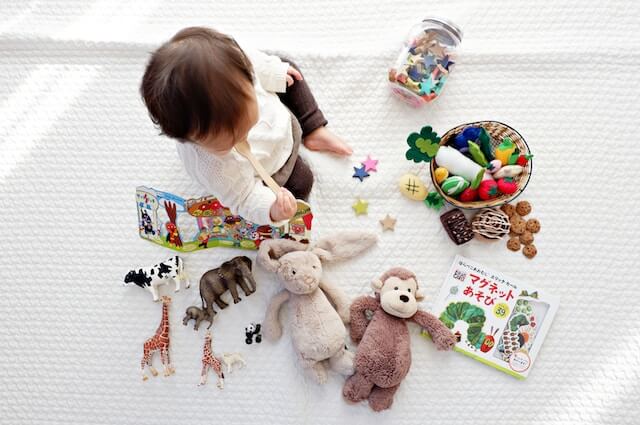
Identifying the signs of autism spectrum disorder in children is an ongoing effort because young kids tend to rapidly grow and acquire new skills between the time that they’re born and their 3rd birthdays.
However, after you're done reading this article, you will know how to spot and address the signs of autism in children at different stages of their early lives.

Early Signs of Autism in Children Under a Year
Kids that are younger than one year of age could show autism spectrum disorder (ASD) symptoms by the time they turn 3 and 7 months old, respectively.
Since kids have many developmental milestones and grow quickly throughout their first year, they will experience different autism symptoms during each of those two life stages.
To clarify, here are the behaviors that may predict ASD among infants and toddlers by age:
Autism Signs By 3 Months
The following ASD symptoms typically appear between the time that a child is born and up until they turn 3 months:
- The boy or girl doesn't smile back at others.
- They can’t maintain eye contact and avoid looking at people's faces when they're spoken to.
- The kid fails to respond to sounds or noises.
- When objects or toys are dangled in front of the boy or girl, they don't follow them with their eyes, try to grab them, or show any interest in them. This is especially the case when it comes to brightly-colored toys since autistic children are sensitive to bright lights.
- The toddler doesn't babble or try to pronounce words. Some kids with ASD babble when they're a few weeks old, but begin to gradually stop doing so as they get closer to being 3 months old.
From there, many autistic infants could go on to show other developmental differences and symptoms between the ages of 3 and 7 months.
Autism Signs By 7 Months
These early signs of autism may indicate that your 7-months-old son or daughter has ASD:
- They don't show any interest in socializing or playing games, such as Peek-A-Boo.
- Instead of grabbing objects or being interested in playing with the mirror, they become obsessed with specific and unusual things like fans and patterns on the floor or ceiling.
- The kid doesn't respond to the word "no".
- The child continues to avoid blabbering or attempting to speak.
- They also don't respond when you call their name. This issue can be particularly concerning if it persists after they turn 9 months old.
Early Signs of Autism in Children Over a Year
During their second year, you may want to keep an eye on potential autism spectrum disorder symptoms and red flags that usually appear when a child reaches 12 months and 18 months of age, respectively.
Here the autism signs that your son or daughter might experience at each of these stages:
At 12 Months
- They don't know how to ask for or point at a toy that they want to play with or grab.
- Instead of imitating people or noises, they become sensitive to sounds and/or uninterested in getting others' attention.
- The girl or boy doesn't make simple gestures, including waving goodbye or nodding their head when they say "yes" or "no".
- Continues to avoid babbling or attempting to pronounce words.
At 18 Months
- The child still hasn't spoken their first words.
- They avoid pointing at toys and objects that they are curious about.
- The kid is extra sensitive around noises and loud voices.
- If they already know how to speak, your boy or girl may start to lose their language skills when they turn 18 months old. However, this problem might not appear until their second birthday.

Signs of Autism in Children That are 2 Years Old
If your child has ASD, most of their early signs of autism will be identifiable by or before the time they turn 24 months.
The following are the main signs of autism are:
- They can't use their words or speak. Keep in mind that many 2-year-old children already know how to use sentences or say multiple words.
- Instead of socializing or playing "pretend", the kid prefers to be alone and avoids trying to find common interests with other children.
- When they imitate or mimic those around them, they do so in a repetitive and obsessive way.
- The boy or girl continues to avoid socializing, communicating with adults, and playing with children.
Since your son or daughter's ASD symptoms will be obvious by this point in their lives, you need to watch out for any regressions in their existing social, behavioral, and sensory skills.
In fact, even if your 2-year-old kid doesn't display any autism signs, you may still want to keep an eye on any potential symptoms of regressive autism. This condition only develops after a child's second birthday.
Regression
Unlike those with early-onset autism, children with regressive ASD experience almost no signs until they turn 24 months to 3 years old. After that, they start to lose some of their capabilities and skills and stop learning new ones.
Here are the most commonplace symptoms and early developmental differences of regressive autism:
- Your boy or girl begins to struggle when they want to pronounce words that they were previously comfortable with.
- You may notice that your son or daughter is no longer gesturing, maintaining eye contact, or using their nonverbal skills.
- The child gradually loses interest in engaging with others, and they revert to watching TV or playing with their toys on their own.
If you suspect that your kid has regressive autism spectrum disorder, they can be diagnosed with autism in the same way as those that have early-onset ASD.
The most effective way to identify and diagnose both regressive and early-onset autism is by having the child get tested at a young age and throughout their first few years in life.

Testing for Autism
Autism screening and testing generally falls under two categories: Developmental screening and a comprehensive behavioral evaluation.
Developmental Screening
Developmental screening entails regularly-scheduled and ongoing visits to the doctor. During each appointment, the doctor will ask you (the parent) and your son or daughter certain questions about the child's development.
Additionally, the doctor might talk to or play with your kid to determine if they have any academic, behavioral, cognitive, and/or sensory issues.
Developmental screening starts before your child is 6 months old, and appointments are recommended when they are 9, 18, 24, and 36 months of age.
The goal of these visits is to either rule out ASD symptoms or, alternatively, undergo further testing if the doctor identifies potential signs of autism.
Comprehensive Behavioral Evaluation
First of all, the doctor who oversees the evaluation may conduct one or more of the following tests:
- A visual and verbal assessment of the boy or girl's developmental patterns and behaviors.
- An interview with the parents.
- Genetic testing.
- Hearing and vision screenings.
- Neurological testing.
- Other medical exams and evaluations.
Next, if they spot any concerns, the doctor will refer you and your child to a specialist who can perform more tests.
For example, they may want you to see a neurologist, children's psychologist/psychiatrist, and/or developmental pediatrician who is formally trained to work with kids that have special needs.
Identifying the Signs of Autism Spectrum Disorder in Children
As mentioned earlier, screening your child for ASD is an ongoing effort, especially throughout the initial 3 years of their lives.
Taking your child to the doctor for assessments at the appropriate time frames is a great way to get diagnosed with autism early, and manage autism at an early stage.
Equally as important, consider using the information that we covered in this article as a preliminary guide on how to spot ASD signs at home and know when it's time to take your son or daughter to the doctor for a checkup.





